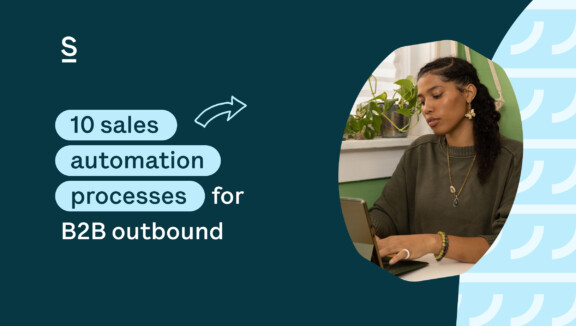10 sales automation processes for B2B outbound

There’s no outbound sales without some kind of sales automation. The rise of automation in sales is driven by innovative tools and the latest trends, reshaping how businesses approach lead generation, customer engagement, and sales strategies. Embracing sales automation has become essential for companies aiming to stay competitive and efficient in the rapidly evolving sales landscape.
Key highlights of Sales Automation
5. Prospect Research Automation
6. Automated Appointment Scheduling
1. Lead Generation Automation
Lead generation, a critical component of sales automation, has been revolutionized by tools like Leadfuze and Growbots. These platforms leverage automation to streamline the process of identifying and capturing potential leads. By utilizing AI, Leadfuze automates the task of finding high-quality leads, analyzing vast data pools to pinpoint those most likely to convert. This capability significantly reduces the time and effort involved in lead generation.
Growbots further enhances sales automation in lead generation by providing a comprehensive database of potential customers. Sales teams can now automate the selection and outreach to these leads, ensuring a more efficient and targeted approach. The integration of AI in these tools underlines the significance of automation in modern lead generation strategies. It’s not just about finding leads; sales automation powered by AI ensures that the leads are of high quality, aligning perfectly with the company’s target audience.
2. Lead Scoring Automation
Automation has transformed lead scoring through AI algorithms. These algorithms analyze multiple factors such as customer interactions, demographic information, and behavioral data. This analysis enables sales teams to prioritize leads based on their likelihood to convert, enhancing the precision of targeting in sales strategies. Automation in lead scoring ensures that sales efforts are focused on the most promising prospects, optimizing resource allocation and increasing conversion rates.
AI-driven Automation tools offer nuanced insights into each lead, factoring in complex variables that go beyond basic analytics. This level of detail in sales automation empowers sales teams to make informed decisions, tailoring their approach to each prospect. The result is a more efficient sales process where efforts are concentrated on leads that exhibit the highest potential for sales success. Sales automation in lead scoring is a testament to how AI can significantly refine and streamline sales operations.
3. Automated Email Campaigns
Automated email campaigns are a cornerstone of sales, with tools like Jasper AI leading the charge. Jasper AI specializes in crafting personalized email scripts, a task integral to any successful sales strategy. This tool not only saves time but also ensures that each communication is tailored to the recipient, increasing the chances of engagement and conversion.
Sales automation in email campaigns is about more than just sending out bulk emails. It involves a strategic approach where every aspect of the email – from the subject line to the call-to-action – is optimized for the target audience. Jasper AI allows sales teams to create diverse email templates that can be used for different segments of their audience, ensuring a personalized touch in large-scale email campaigns.
This approach to sales automation in email marketing reflects the evolving nature of customer engagement. In an era where personalized communication is key, sales automation tools like Jasper AI are indispensable for sales teams looking to scale their outreach efforts without sacrificing the quality and relevance of their messages.
4. Follow-up Email Automation
Follow-up email automation is a critical aspect of sales, addressing one of the most common challenges in sales – maintaining consistent engagement with prospects. Automated follow-ups ensure that no potential lead falls through the cracks due to missed communications. This tactic is particularly valuable in nurturing leads that are not yet ready to make a purchase but might do so in the future.
Sales automation in follow-up emails allows sales teams to set predefined triggers based on prospect actions or inactions. For instance, if a prospect has not responded to an initial email within a certain timeframe, an automated follow-up email can be sent. This level of automation in sales ensures timely and relevant communication, keeping the conversation with prospects alive and active.
Follow-up emails offers the ability to personalize messages based on the prospect’s previous interactions with the brand. This strategy not only enhances the effectiveness of follow-ups but also contributes to building a relationship with the prospect. Tools that enable these automated, yet personalized follow-ups are crucial in today’s fast-paced sales environment, where timely and relevant engagement can make the difference in converting a lead.
5. Prospect Research Automation
Prospect research automation is a vital facet of sales automation, significantly enhancing the efficiency and effectiveness of sales strategies. Automation tools in sales provide a comprehensive understanding of prospects by gathering and analyzing vast amounts of data from various sources. This process includes examining social media activities, website interactions, and other online behaviors of potential customers.
By automating the prospect research process, sales teams can quickly identify key insights about their prospects, such as their interests, pain points, and buying habits. This level of detailed understanding, facilitated by sales automation, allows for a more tailored and impactful sales approach. Automation in prospect research ensures that sales efforts are not only strategic but also highly targeted and personalized.
The integration of automation in prospect research tools also allows for continuous updating of prospect information, ensuring that sales teams always have the most current data at their disposal. This real-time update capability of sales automation tools is crucial in a rapidly changing market environment, where staying abreast of prospect changes can be the key to successful sales engagement.
In can also include tools that automatically find the email address of your prospects on LinkedIn.

Find emails for free with Surfe
Get that email address of your key prospects in one click. Everything automatically synced with your CRM or Google Sheet and available to try out for free.
6. Automated Appointment Scheduling
Automated appointment scheduling is an essential component of sales automation, streamlining one of the most time-consuming aspects of the sales process. Tools like Calendly play a pivotal role in this area of sales automation, simplifying the coordination of meetings between sales representatives and their prospects. This automation in sales removes the back-and-forth typically associated with scheduling appointments, freeing up valuable time for sales teams to focus on more strategic activities.
Calendly and similar sales automation tools offer a seamless interface where prospects can view available time slots and book appointments based on their convenience. This level of user-friendliness in sales automation not only enhances the prospect’s experience but also significantly reduces the administrative burden on sales teams. By automating appointment scheduling, sales teams can efficiently manage their calendars, ensuring that they are maximizing their time and opportunities.
Additionally, sales automation in appointment scheduling often integrates with other tools such as CRM systems, email platforms, and video conferencing tools. This integration ensures that all aspects of the appointment are managed effectively and that sales teams have all the necessary information at their fingertips. In the fast-paced world of sales, automation in appointment scheduling is a game-changer, offering both efficiency and improved customer experience.
7. CRM Data Entry Automation
CRM data entry automation is a critical aspect of sales automation, designed to enhance the accuracy and efficiency of maintaining customer information. By integrating sales automation tools with CRM systems, the process of entering and updating customer data is streamlined, significantly reducing the risk of human error. This automation in sales ensures that CRM databases are always current and reliable, providing sales teams with the most up-to-date information about their prospects and customers.
Sales automation in CRM data entry is particularly beneficial in managing large volumes of customer interactions. As sales teams engage with multiple prospects across various channels, manually updating CRM systems can be laborious and prone to errors. Automation in this aspect of sales solves this problem by automatically capturing and recording every interaction, whether it’s an email exchange, a phone call, or a social media conversation.
Furthermore, sales automation in CRM data entry supports the development of more personalized sales strategies. With accurate and comprehensive data readily available, sales teams can tailor their approach to each prospect, enhancing the likelihood of successful conversions. Automation in CRM data management is not just a tool for efficiency; it’s a strategic asset in building deeper, more meaningful customer relationships.
8. Lead Nurturing Automation
Lead nurturing automation is an integral part of sales automation, focusing on developing relationships with prospects at every stage of the sales funnel. Automated lead nurturing sequences engage prospects with timely and relevant content, guiding them through the buying journey. This sales automation strategy is key in converting leads into customers by providing them with the information and support they need at the right moment.
Through sales automation, businesses can set up a series of automated emails or other communications that are triggered based on specific actions taken by the prospect. For example, if a prospect downloads a whitepaper, an automated email sequence can be initiated, providing more information on the topic and gently nudging the prospect towards a sale. This level of sales automation ensures that each prospect receives a personalized experience, increasing the effectiveness of the nurturing process.
Automation in lead nurturing is not just about sending emails; it encompasses a range of activities, including social media engagement, webinar invitations, and targeted content delivery. By leveraging sales automation tools, businesses can maintain a consistent and meaningful dialogue with their prospects, building trust and establishing their brand as a valuable resource. In a landscape where nurturing leads is as important as generating them, sales automation in lead nurturing is indispensable for sustained business growth.
9. Social Media Outreach Automation
Social media outreach automation is a significant aspect of sales automation, enabling businesses to efficiently manage their interactions on platforms like LinkedIn. Sales automation tools automate various tasks, including posting updates, responding to comments, and reaching out to potential leads. This approach to sales automation allows sales teams to maintain a consistent and active presence on social media without the need for continuous manual effort.
In the realm of sales automation, tools specifically designed for LinkedIn outreach have become increasingly popular. They automate the process of connecting with prospects, sending personalized messages, and following up on interactions. Sales automation in social media outreach is particularly useful for scaling efforts and reaching a larger audience without compromising the quality of engagement.
Moreover, sales automation on social media platforms provides valuable analytics and insights into the effectiveness of outreach strategies. Sales teams can track engagement rates, measure the impact of their messages, and adjust their approach based on data-driven insights. The integration of sales automation in social media outreach not only enhances efficiency but also ensures that the efforts are strategically aligned with the overall sales goals.
10. Sales Reporting Automation
Sales reporting automation is a crucial element of sales automation, streamlining the process of tracking and analyzing sales performance. Sales automation tools generate comprehensive reports automatically, providing insights into various metrics such as conversion rates, sales cycle length, and customer engagement. This aspect of sales automation saves time and effort for sales teams, allowing them to focus more on strategic activities rather than on manual report generation.
The power of sales automation in reporting lies in its ability to offer real-time data and trends. Sales teams can access up-to-date information at any moment, enabling quick decision-making and strategy adjustments. Sales automation in reporting provides a clear view of what’s working and what isn’t, guiding sales teams in optimizing their efforts for better results.
Furthermore, sales automation in reporting facilitates a more collaborative environment. Sales teams can share reports easily, ensuring that all members are aligned and informed about the team’s performance and objectives. Sales automation tools often integrate with other platforms, such as CRMs and marketing automation systems, providing a comprehensive overview of the sales and marketing efforts. In today’s data-driven sales landscape, automation in sales reporting is essential for maintaining a competitive edge.

Take your sales automation to the next step with Surfe.
Connect LinkedIn to your CRM and never worry about manual data entry again.
Let’s wrap it up!
The transformative impact of sales automation, no matter if its outbound vs inbound, cannot be overstated. By embracing sales automation technologies, businesses can achieve enhanced efficiency and effectiveness in their sales processes. From lead generation to customer nurturing, sales automation tools provide invaluable support in every step of the sales journey. As the sales landscape continues to evolve, adopting sales automation is not just an option but a necessity for businesses seeking to thrive in this dynamic environment. Sales automation is the key to unlocking greater productivity, improved customer relationships, and ultimately, sustained business success.


